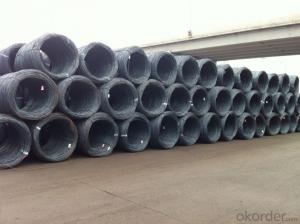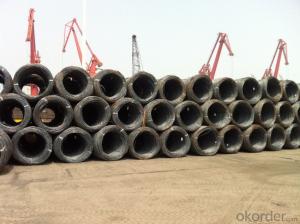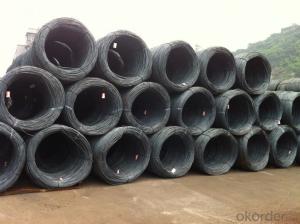SAE1008 Wire Rods with Best Quality and Price
- Loading Port:
- Tianjin
- Payment Terms:
- TT OR LC
- Min Order Qty:
- 25 m.t.
- Supply Capability:
- 20000 m.t./month
OKorder Service Pledge
OKorder Financial Service
You Might Also Like
Item specifice
Grade: SAE1008 Standard: ASTM
Diameter: 5.5mm, 6.5mm, 7mm, 8mm, 9mm, 10mm, 11mm, 12mm
Alloy or Not: Alloy
Technique: Hot Rolled Place of Origin: China Mainland
Chemical Composition:
Please kindly find our chemistry of our material based on SAE1008 as below for your reference:
Grade | Chemical Composition (%) | |||||
C | Mn | S | P | Si | B | |
SAE1008 | 0.10max | 0.30-0.50 | 0.050max | 0.040max | 0.30max | 0.0008min |
Mechanical properties | ||||||
Yield strength(N/mm2) | Tensile strength(N/mm2) | Elongation (%) | ||||
≥195 | 350-380 | ≥32 | ||||
Usage and Applications of Wire Rod:
After hot-rolled the products shaped into coil and delivery as finished product, including round, square,rectangular, hexagonal and so on. Since most of the products are round, it is generally called wire rod. Carbon steel wire rod is widely used in construction and manufacturing. Carbon steel wire rod is mainly used for reinforcement of reinforced concrete and welded structure or reprocessed (roberts , nail, etc.) materials, especially used to produce wire drawing, welding electrode, nails, spring, electronic, precise machinery parts and so on.
Packaging & Delivery of Wire Rod:
Packaging Detail: products are packed in coil and then shipped by container or bulk vessel
Each coil weight: About 2.05MT
Delivery Detail: within 45 days after received deposit or LC.
Label: to be specified by customer, generally, each bundle has 1-2 labels
Trade terms: FOB, CFR, CIF
FAQ:
Q1: How soon can we receive the product after purchasement?
A1: Within three days of placing an order, we will begin production. The specific shipping date is dependent upon international and government factors, but is typically one month.
Q2: How do you guarantee the quality of our products?
A2: We have established an advanced quality management system which conducts strict quality tests at every step, from raw materials to the final product. At the same time, we provide extensive follow-up service assurances as required.
Q1: Why buy Materials & Equipment from OKorder.com?
A1: All products offered by OKorder.com are carefully selected from China's most reliable manufacturing enterprises. Through its ISO certifications, OKorder.com adheres to the highest standards and a commitment to supply chain safety and customer satisfaction.
Images of Wire Rod
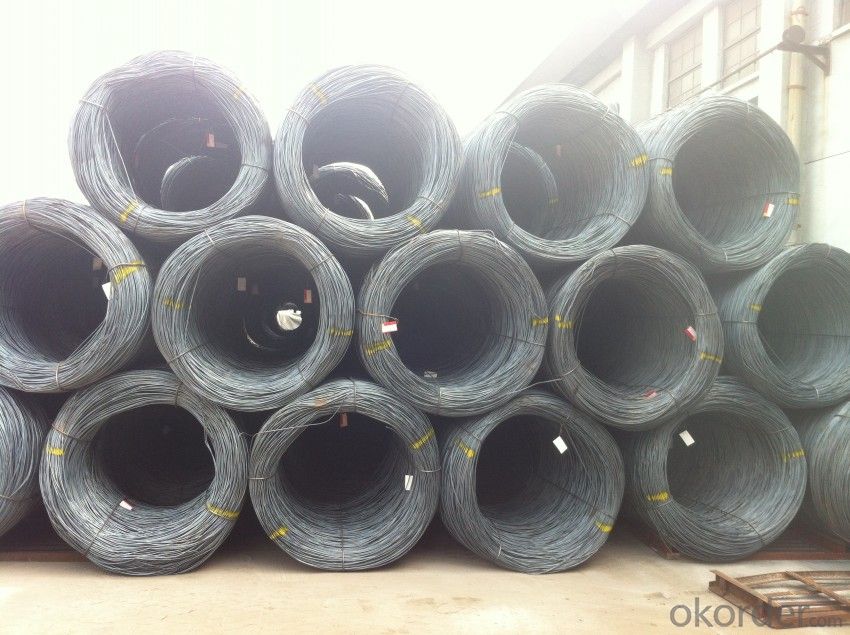
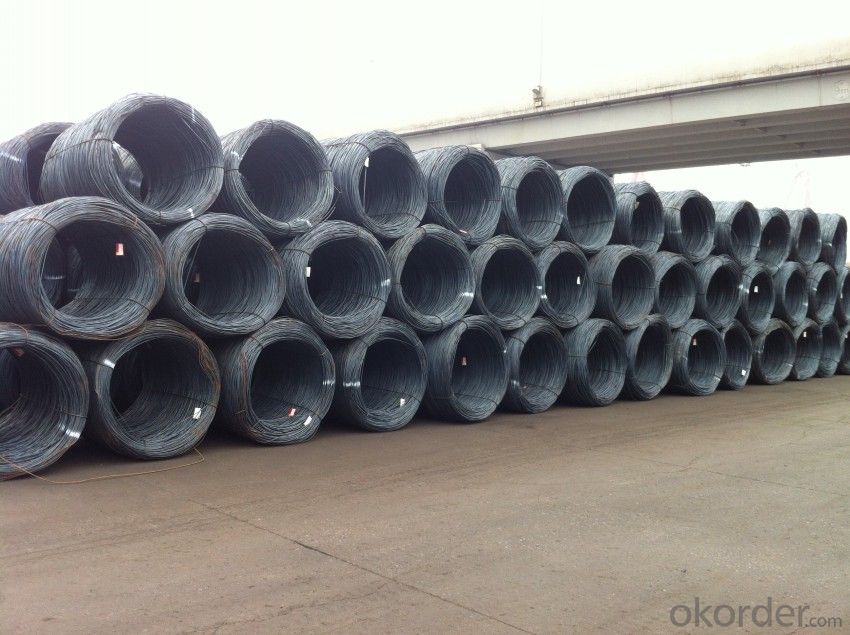
- Q:What are the different types of steel wire rod coating processes?
- There are several different types of steel wire rod coating processes used in the industry. These processes are designed to provide various levels of protection and enhance the performance of the wire rod in different applications. Some of the commonly used coating processes include: 1. Galvanizing: This process involves coating the steel wire rod with a layer of zinc. Galvanizing provides excellent corrosion resistance and is widely used in outdoor applications where the wire is exposed to harsh weather conditions. 2. Phosphate coating: Phosphate coating is a chemical process that involves treating the surface of the steel wire rod with phosphate compounds. This coating enhances the adhesion of subsequent coatings, such as paint or powder coating, and improves corrosion resistance. 3. Electroplating: In electroplating, a thin layer of metal, such as chromium or nickel, is deposited onto the surface of the steel wire rod using an electric current. This process provides improved corrosion resistance and enhances the appearance of the wire rod. 4. Polymer coating: Polymer coating involves applying a layer of polymer material, such as PVC or polyethylene, onto the surface of the steel wire rod. This coating provides protection against corrosion, abrasion, and chemical exposure, making it suitable for a wide range of applications. 5. Epoxy coating: Epoxy coating is a type of polymer coating that utilizes epoxy resin to provide a durable and corrosion-resistant layer on the steel wire rod. This coating is commonly used in applications where high chemical resistance and mechanical strength are required. 6. Aqueous film forming foam (AFFF) coating: AFFF coating is primarily used in the steel wire rod for fire-resistant applications. It forms a thin layer of foam on the surface, which acts as a barrier against heat and fire, providing protection to the wire rod. It is important to select the appropriate coating process based on the specific requirements of the application to ensure optimal performance and longevity of the steel wire rod.
- Q:How is the toughness of steel wire rod determined?
- The toughness of steel wire rod is determined through various mechanical tests such as the Charpy impact test, which measures the material's ability to absorb energy without fracturing. Other tests, such as tensile strength and hardness tests, also contribute to understanding the toughness of steel wire rod.
- Q:What are the advantages of using steel wire rod?
- There are several advantages of using steel wire rod. Firstly, steel wire rod is known for its high tensile strength, which makes it suitable for applications that require extra durability and strength. Secondly, steel wire rod has excellent corrosion resistance properties, making it a reliable choice for outdoor and marine applications where exposure to moisture and harsh weather conditions is common. Additionally, steel wire rod has good formability and can be easily shaped and bent without losing its strength, allowing for versatile applications in various industries. Moreover, steel wire rod is cost-effective and readily available, making it a cost-efficient choice for manufacturers and construction projects. Overall, the advantages of using steel wire rod include its strength, corrosion resistance, formability, and cost-effectiveness.
- Q:What are the different welding techniques used for steel wire rod?
- There are several welding techniques used for steel wire rod, including MIG (Metal Inert Gas) welding, TIG (Tungsten Inert Gas) welding, spot welding, and flash butt welding. Each technique has its own advantages and is suitable for different applications. MIG welding is commonly used for its speed and versatility, while TIG welding offers precise control and high-quality welds. Spot welding is used for joining thin wire rods, and flash butt welding is utilized for larger diameter wire rods. The choice of welding technique depends on the specific requirements of the project and the desired outcome.
- Q:How is the decarburization of steel wire rod evaluated?
- The decarburization of steel wire rod is evaluated through various methods and techniques to ensure the quality and properties of the final product. One common evaluation method is through visual inspection, where the surface of the wire rod is examined for any signs of decarburization such as discoloration or scaling. This can provide a preliminary assessment of the level of decarburization. In addition to visual inspection, chemical analysis is performed to determine the carbon content at different depths of the wire rod. This is usually done by taking samples from different sections of the wire rod and subjecting them to a carbon analysis test. The results of this analysis can reveal the extent of decarburization and help in assessing its impact on the mechanical properties of the steel wire rod. Microscopic examination is also an important evaluation technique. Metallographic analysis involves preparing thin sections of the wire rod and examining them under a microscope. This allows for a detailed examination of the microstructure and identification of any decarburized areas. The depth and severity of decarburization can be measured using specialized equipment, such as image analysis software, which helps quantify the decarburization depth. Furthermore, mechanical testing is conducted to assess the impact of decarburization on the wire rod's mechanical properties. Tensile strength, hardness, and ductility tests are commonly performed to evaluate the wire rod's overall strength and behavior under different conditions. Any significant deviation from the desired mechanical properties may indicate a higher level of decarburization. Overall, the evaluation of decarburization in steel wire rod involves a combination of visual inspection, chemical analysis, microscopic examination, and mechanical testing. These techniques provide a comprehensive understanding of the extent and impact of decarburization, ensuring that the wire rod meets the required quality standards and specifications.
- Q:What are the different types of wire mesh for sieving made from steel wire rod?
- There are several different types of wire mesh for sieving that are made from steel wire rod. These types include: 1. Plain weave wire mesh: This is the most common type of wire mesh used for sieving. It is made by weaving the steel wire rods together in an over-and-under pattern, creating a square or rectangular mesh structure. Plain weave wire mesh is known for its simplicity and versatility. 2. Twill weave wire mesh: Twill weave wire mesh is similar to plain weave, but the wires are interlaced in a diagonal pattern, creating a tighter mesh structure. This type of wire mesh is often used for fine sieving applications where a higher level of precision is required. 3. Dutch weave wire mesh: Dutch weave wire mesh is made by weaving the wires in an over-and-under pattern, but with different wire diameters for the warp and weft wires. This creates a mesh with smaller openings in one direction, making it ideal for applications where fine particles need to be separated. 4. Welded wire mesh: Welded wire mesh is made by welding the intersecting points of the steel wires together, creating a strong and durable mesh structure. This type of wire mesh is commonly used for heavy-duty sieving applications, such as in construction or industrial settings. 5. Expanded metal mesh: Expanded metal mesh is made by cutting and stretching a flat sheet of steel, creating a mesh with diamond-shaped openings. This type of wire mesh is known for its strength and rigidity, making it suitable for sieving applications that require high impact resistance. Overall, the different types of wire mesh for sieving made from steel wire rod offer a range of options to suit various sieving needs, from basic to more specialized applications. The choice of wire mesh will depend on factors such as the size of the particles being sieved, the desired level of precision, and the intended use of the sieved material.
- Q:How does the diameter of steel wire rod affect its strength?
- The diameter of a steel wire rod directly affects its strength. Generally, a larger diameter wire rod will have higher strength compared to a smaller diameter wire rod. This is because a larger diameter rod has a greater cross-sectional area, allowing it to withstand higher loads and stresses without breaking or deforming.
- Q:What are the common sizes and dimensions of steel wire rod?
- Steel wire rod is available in various sizes and dimensions to cater to different industrial applications. The common sizes and dimensions of steel wire rod typically vary based on the specific requirements and standards set by the industry. However, there are some commonly used sizes and dimensions that are widely available in the market. One of the most common sizes of steel wire rod is 5.5mm, which is widely used in the construction industry for reinforcement purposes. Another frequently used size is 6mm, which is also popular in construction and manufacturing applications. Additionally, steel wire rod is available in sizes such as 8mm, 10mm, and 12mm, which are commonly used in construction, automotive, and general manufacturing industries. In terms of dimensions, steel wire rod is usually produced in coils, with typical coil weights ranging from 1 to 3 metric tons. The diameter of the coils can vary, but they are typically around 1.2 to 1.5 meters. The coil inner diameter is usually in the range of 800 to 1,000 millimeters. It is important to note that the sizes and dimensions of steel wire rod can vary based on the specific requirements of the industry or project. It is always advisable to consult the relevant standards and specifications to ensure the correct selection of steel wire rod for a particular application.
- Q:What are the recent developments and innovations in steel wire rod production?
- Recent developments and innovations in steel wire rod production include the use of advanced technologies such as continuous casting and direct rolling, which improve the quality and efficiency of the production process. Additionally, there has been a focus on developing new alloys and coatings to enhance the strength, durability, and corrosion resistance of steel wire rods. Furthermore, automation and digitization have been introduced to optimize the production line, reduce energy consumption, and minimize waste. Overall, these advancements aim to meet the increasing demands of various industries and ensure the production of high-quality steel wire rods.
- Q:How are steel wire rods tested for quality control?
- To ensure that steel wire rods meet the necessary standards and specifications, they undergo a series of rigorous quality control procedures. These procedures consist of various stages that evaluate the physical, mechanical, and chemical properties of the wire rods. Initially, a visual inspection is conducted to identify any visible defects, such as surface cracks, irregularities, or deformities, that could impact the overall quality of the wire rods. Following that, dimensional measurements are taken to verify the diameter, length, and straightness of the wire rods. This step ensures that the wire rods adhere to the specified tolerances and fall within acceptable limits. Afterwards, mechanical testing is performed to assess the strength and durability of the wire rods. This involves conducting tensile strength tests to determine the maximum load the wire rods can bear before breaking. This test is crucial in evaluating the material's ability to withstand external forces and is essential for assessing overall quality. Chemical analysis is another vital aspect of quality control testing. It involves testing the wire rods' chemical composition to verify that they contain the required elements in the specified proportions. This analysis is essential in determining the material's suitability for its intended application and ensuring compliance with industry standards. Moreover, non-destructive testing methods, such as ultrasonic testing or magnetic particle inspection, may be employed to detect internal flaws or defects that may not be visible to the naked eye. These testing techniques assist in identifying any hidden issues that could compromise the quality of the wire rods. In conclusion, the quality control process for steel wire rods encompasses visual inspection, dimensional measurements, mechanical testing, chemical analysis, and non-destructive testing. By adhering to these stringent quality control measures, manufacturers can guarantee that their wire rods meet the required standards and provide customers with reliable and high-quality products.
1. Manufacturer Overview |
|
|---|---|
| Location | |
| Year Established | |
| Annual Output Value | |
| Main Markets | |
| Company Certifications | |
2. Manufacturer Certificates |
|
|---|---|
| a) Certification Name | |
| Range | |
| Reference | |
| Validity Period | |
3. Manufacturer Capability |
|
|---|---|
| a)Trade Capacity | |
| Nearest Port | |
| Export Percentage | |
| No.of Employees in Trade Department | |
| Language Spoken: | |
| b)Factory Information | |
| Factory Size: | |
| No. of Production Lines | |
| Contract Manufacturing | |
| Product Price Range | |
Send your message to us
SAE1008 Wire Rods with Best Quality and Price
- Loading Port:
- Tianjin
- Payment Terms:
- TT OR LC
- Min Order Qty:
- 25 m.t.
- Supply Capability:
- 20000 m.t./month
OKorder Service Pledge
OKorder Financial Service
Similar products
New products
Hot products
Related keywords
